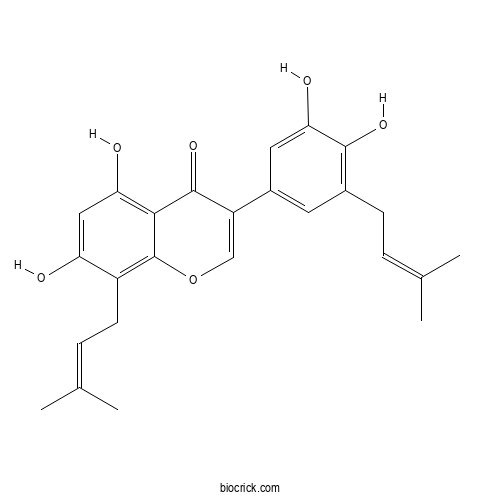Glyurallin BCAS# 199331-53-8 |

Quality Control & MSDS
3D structure
Package In Stock
Number of papers citing our products

| Cas No. | 199331-53-8 | SDF | Download SDF |
| PubChem ID | 15818599.0 | Appearance | Powder |
| Formula | C25H26O6 | M.Wt | 422.17 |
| Type of Compound | N/A | Storage | Desiccate at -20°C |
| Solubility | Soluble in Chloroform,Dichloromethane,Ethyl Acetate,DMSO,Acetone,etc. | ||
| Chemical Name | 3-[3,4-dihydroxy-5-(3-methylbut-2-enyl)phenyl]-5,7-dihydroxy-8-(3-methylbut-2-enyl)chromen-4-one | ||
| SMILES | CC(=CCC1=C(C(=CC(=C1)C2=COC3=C(C(=CC(=C3C2=O)O)O)CC=C(C)C)O)O)C | ||
| Standard InChIKey | DPLWUTYEBRKBLI-UHFFFAOYSA-N | ||
| Standard InChI | InChI=1S/C25H26O6/c1-13(2)5-7-15-9-16(10-21(28)23(15)29)18-12-31-25-17(8-6-14(3)4)19(26)11-20(27)22(25)24(18)30/h5-6,9-12,26-29H,7-8H2,1-4H3 | ||
| General tips | For obtaining a higher solubility , please warm the tube at 37 ℃ and shake it in the ultrasonic bath for a while.Stock solution can be stored below -20℃ for several months. We recommend that you prepare and use the solution on the same day. However, if the test schedule requires, the stock solutions can be prepared in advance, and the stock solution must be sealed and stored below -20℃. In general, the stock solution can be kept for several months. Before use, we recommend that you leave the vial at room temperature for at least an hour before opening it. |
||
| About Packaging | 1. The packaging of the product may be reversed during transportation, cause the high purity compounds to adhere to the neck or cap of the vial.Take the vail out of its packaging and shake gently until the compounds fall to the bottom of the vial. 2. For liquid products, please centrifuge at 500xg to gather the liquid to the bottom of the vial. 3. Try to avoid loss or contamination during the experiment. |
||
| Shipping Condition | Packaging according to customer requirements(5mg, 10mg, 20mg and more). Ship via FedEx, DHL, UPS, EMS or other couriers with RT, or blue ice upon request. | ||

Glyurallin B Dilution Calculator

Glyurallin B Molarity Calculator
| 1 mg | 5 mg | 10 mg | 20 mg | 25 mg | |
| 1 mM | 2.3687 mL | 11.8436 mL | 23.6871 mL | 47.3743 mL | 59.2179 mL |
| 5 mM | 0.4737 mL | 2.3687 mL | 4.7374 mL | 9.4749 mL | 11.8436 mL |
| 10 mM | 0.2369 mL | 1.1844 mL | 2.3687 mL | 4.7374 mL | 5.9218 mL |
| 50 mM | 0.0474 mL | 0.2369 mL | 0.4737 mL | 0.9475 mL | 1.1844 mL |
| 100 mM | 0.0237 mL | 0.1184 mL | 0.2369 mL | 0.4737 mL | 0.5922 mL |
| * Note: If you are in the process of experiment, it's necessary to make the dilution ratios of the samples. The dilution data above is only for reference. Normally, it's can get a better solubility within lower of Concentrations. | |||||

Calcutta University

University of Minnesota

University of Maryland School of Medicine

University of Illinois at Chicago

The Ohio State University

University of Zurich

Harvard University

Colorado State University

Auburn University

Yale University

Worcester Polytechnic Institute

Washington State University

Stanford University

University of Leipzig

Universidade da Beira Interior

The Institute of Cancer Research

Heidelberg University

University of Amsterdam

University of Auckland

TsingHua University

The University of Michigan

Miami University

DRURY University

Jilin University

Fudan University

Wuhan University

Sun Yat-sen University

Universite de Paris

Deemed University

Auckland University

The University of Tokyo

Korea University
- IsochlorogenicacidA 3,5-Dicaffeoylquinicacid
Catalog No.:BCX0962
CAS No.:89919-62-0
- 1-p-coumaroyl-3-caffeoylquinicacid
Catalog No.:BCX0961
CAS No.:2459224-35-0
- 1-O-trans-caffeoyl-5-O-trans-p-coumaroylquinicacid
Catalog No.:BCX0960
CAS No.:1401532-34-0
- 1,5-di-O-p-coumaroylquinicacid
Catalog No.:BCX0959
CAS No.:1239620-73-5
- Furo[3',4':6,7]naphtho[2,3-d]-1,3-dioxol-6(5aH)-one,5,8,8a,9-tetrahydro-5-(3,4,5-trimethoxyphenyl)- (9CI)
Catalog No.:BCX0958
CAS No.:69222-20-4
- Liquiritigenin-7-O-apiosyl(1-2)-glucoside
Catalog No.:BCX0957
CAS No.:135432-48-3
- 10-Hydroxycamptothecin acetate
Catalog No.:BCX0956
CAS No.:951770-22-2
- Dehydroeburicoic acid monoacetate
Catalog No.:BCX0955
CAS No.:77035-42-8
- ThonningianinB
Catalog No.:BCX0954
CAS No.:271579-12-5
- (25R)-Spirost-4-en-3,12-dion
Catalog No.:BCX0953
CAS No.:6875-60-1
- Nitidine
Catalog No.:BCX0952
CAS No.:6872-57-7
- SpicatosideA
Catalog No.:BCX0951
CAS No.:128397-47-7
- Gancaonin L
Catalog No.:BCX0964
CAS No.:129145-50-2
- Cyanidin3-O-(6-(E)-Feruloyl)-β-D-glucopyranoside-(2-O-(E)-sinapoyl-β-D-glucopyranosyl)-β-D-glucopyranosyl-5-glucopyranoside
Catalog No.:BCX0965
CAS No.:765863-34-1
- Cyanidin3-O-(6-O-(E)-Feruloyl-β-D-glucopyranosyl(2-O-(E)-Feruloyl-β-D-glucopyranosyl)-glucopyranoside-5-O-glucopyranoside
Catalog No.:BCX0966
CAS No.:942192-63-4
- Cyanidin3-(6-(2-(p)-coumarate-β-D-glucopyranosyl)-β-D-glucopyranosyl)-5-glucopyranoside
Catalog No.:BCX0967
CAS No.:771448-35-2
- Cyanidin3-(6-(E)-coumarin)-(2-(E)-sinapoyl-β-D-glucopyranosyl)-β-D-glucopyranosyl)-5-glucopyranoside
Catalog No.:BCX0968
CAS No.:117894-45-8
- Cyanidin3-(6-(2-(E)-sinapoyl-β-D-glucopyranosyl)-β-D-glucopyranosyl)-5-(6-(E)-sinapoyl)-β-D-glucopyranoside
Catalog No.:BCX0969
CAS No.:1978410-75-1
- 4-Desoxypicropodophyllotoxin
Catalog No.:BCX0970
CAS No.:24150-39-8
- (1R,4E,9E,11S)-4,12,12-trimethyl-8-oxobicyclo[9.1.0]dodeca-4,9-dien-2-yl acetate
Catalog No.:BCX0971
CAS No.:1350083-66-7
- 7,2'-Dimethoxyisomucronulatol
Catalog No.:BCX0972
CAS No.:60478-76-4
- 2'-O-Methylisomucronulatol
Catalog No.:BCX0973
CAS No.:2243403-57-6
- Hericenone D
Catalog No.:BCX0974
CAS No.:137592-04-2
- Hericenone C
Catalog No.:BCX0975
CAS No.:137592-03-1
Antioxidant and anti-inflammatory activities of six flavonoids separated from licorice.[Pubmed:23790887]
Food Chem. 2013 Nov 15;141(2):1063-71.
Licorice, the roots and rhizomes of several Glycyrrhiza species (Leguminosae), is an important natural sweetening agent and a widely used herbal medicine. In this work, six flavonoids, 5-(1,1-dimethylallyl)-3,4,4'-trihydroxy-2-methoxychalcone (1), licochalcone B (2), licochalcone A (3), echinatin (4), glycycoumarin (5) and Glyurallin B (6), were isolated from the extracts of licorice (Glycyrrhiza inflata and Glycyrrhiza uralensis). Their structures were elucidated using various spectroscopic methods. To our knowledge, compound 1 was isolated from natural plants for the first time. All the isolates were tested by antioxidant and anti-inflammatory assays. Compounds 2, 4 and 5 showed strong scavenging activity toward the ABTS(+) radical, and compounds 1, 2, 3, 5 and 6 exhibited potent inhibition of lipid peroxidation in rat liver microsomes compared with the reference controls. Compounds 1-4 dose-dependently inhibited LPS induced reactive oxygen species (ROS) production in RAW 264.7 cells. Furthermore, compounds 1-5 were demonstrated to inhibit the production of nitric oxide (NO), interleukin-6 (IL-6) and prostaglandin E2 (PGE2) in LPS-induced macrophage cells. Moreover, the contents of the six compounds, in different Glycyrrhiza species, were quantified by HPLC-MS.


